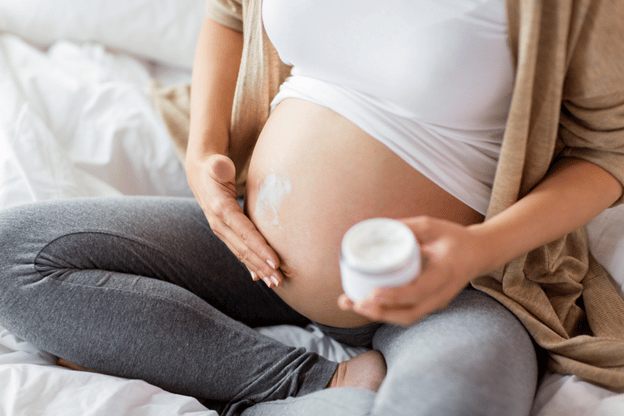Pregnancy can be one of the most exciting times in a woman’s life. While some women are “unicorns” and experience the best complexion and hair of their lives, others feel as if their skin has been “hijacked” and that virtually every day brings something foreign or unknown emerging on their face or body.
Dr. Sheel Solomon is a Raleigh-Durham, North Carolina Board- Certified Dermatologist. She is a mother to two young children and understands first-hand what a woman’s skin and hair go through during pregnancy.
Here she shares common concerns and what a woman can do postpartum to regain skin and hair status quo.
Stretch Marks
Stretch marks happen when your body grows faster than your skin can keep up with. This causes the elastic fibres just under the surface of the skin to break, resulting in stretch marks.
Growing that fast can leave you with stretch marks, especially on your belly and breasts, two areas that grow the most. Stretch marks can also show up on the thighs, buttocks, and upper arms.
The marks often start out reddish or purple, but after pregnancy, they gradually fade to white or gray. “Unfortunately, there’s no way to prevent stretch marks.
There’s not a cream, lotion, or “mommy” potion that can do that. If that’s the claim on the bottle, don’t be duped,” says Dr. Solomon.
“The Glow“
It isn’t an urban legend. It’s real and it’s awesome. “Because of increased blood flow and expanded capillaries, at some point in your pregnancy, your skin will effortlessly start to beam.
People will likely notice that something is just different about you, and your skin will probably never experience so many compliments again, says Dr. Solomon.
In addition to added blood circulation, pregnancy hormones cause your skin to naturally retain more moisture, thus giving you your radiance.
This is one of those side effects that we wish would stick around, but it’s likely that it will eventually fade as your hormones level out. It’s always a good idea to keep your skin hydrated with a rich lotion or cream,
Dr. Solomon says, especially if it makes your skin feel better, look smoother and more toned, and helps the itchiness that can come with your growing belly.
Skin tags
These small, loose, harmless growths of the skin can appear anywhere on your body during pregnancy, but most commonly pop up under the arms and breasts. Unfortunately, there’s nothing you can do to prevent them, but they can easily be removed after pregnancy if you want.
Varicose and spider veins
Varicose veins are those blue or purple veins that usually, show up on the legs, and spider veins are the tiny red veins that may appear on your face when you’re pregnant.
The good news: Both usually clear up after your baby is born. In the event that they don’t, Dr. Solomon explains that Sclerotherapy involves an injection of a solution directly into the vein that causes them to shrink.
Acne
Zits aren’t just for teenagers: Many moms-to-be also get acne throughout their pregnancy, even if they’ve never had it before.
Dr. Solomon explains that “Two things conspire to cause breakouts, which tend to hit sometime around week 6 of pregnancy: hormone surges, of course (in this case, progesterone, which causes your glands to increase acne-causing secretions of oil, called sebum) can clog up pores and cause bacteria to build up, leading to breakouts. And your body is also retaining more fluids, which contain toxins that can lead to **acne.”
Cholestasis of pregnancy
Dr. Solomon cautions that “There are times you shouldn’t ignore itchy skin. Cholestasis of pregnancy is a liver disease that results from high amounts of pregnancy hormones affecting the normal flow of bile in the gallbladder.
This condition occurs in the third trimester and can cause severe itching over the whole body. It’s often worse on the palms and soles of the feet and causes patients to feel miserable and unable to sleep.
Cholestasis of pregnancy also may be accompanied by jaundice (a yellow discolouration of the skin and eyes).”
A simple blood test can verify if you have cholestasis of pregnancy, and oral medication may treat it. Delivery also cures it, so OB-GYNS may induce labour when you are closer to your due date.
Melasma and linea nigra
If you develop dark splotches on your face, you could have melasma or the mask of pregnancy. This skin condition affects up to half of the pregnant women and is also responsible for linea nigra, a dark line that runs down the belly.
Hair and nail changes
You may notice that your hair suddenly seems thicker and fuller or that your nails grow faster during pregnancy. These changes are due to pregnancy hormones. Unfortunately, you may also find that hair starts to grow where you’d prefer it didn’t, including on your face, chest, and belly.
Quick Tips for Post-Pregnancy Skin
- Hydrate with water
- Do yoga and practice relaxation techniques
- Use an oil-free moisturizer to avoid acne
- Avoid direct exposure to the sun to control pigmentation and wear a good broad-spectrum high SPF sunscreen
- Use a good under-eye cream for puffy eyes and dark circles
- Exfoliate your body all over with a gentle exfoliator stimulate circulation
- Don’t stop taking your prenatal vitamins. They also are beneficial to the health of your skin, hair, and nails, as they provide iron and calcium.
